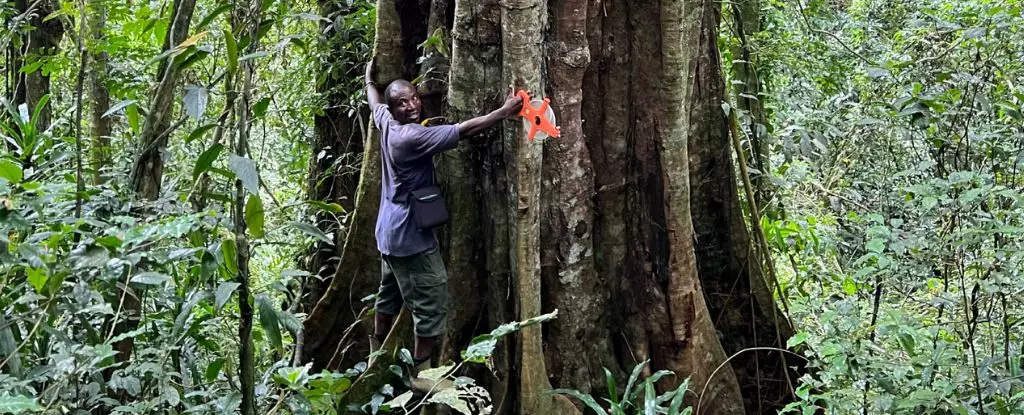In an extraordinary revelation, scientists have uncovered a tree species previously unknown to science, nested in the moist heart of Tanzania’s Udzungwa mountains. The tree, Tessmannia princeps, is not just a botanical marvel; it potentially stands witness to over 3,000 years of ecological history. As our world grapples with the ravages of climate change and habitat destruction, the discovery of such magnificent specimens serves not only as a gift from nature but also as a clarion call for urgent action.
The encounter that led to the recognition of T. princeps unfolded when botanist Andrea Bianchi and his dedicated team found themselves in the presence of a majestic 40-meter tall tree adorned with buttressed roots, a rarity that stirred their scientific curiosity. This “unarmed” tree, as it was described, punched through the canopy with grace and mystery. Its bark of light brown hue and leaves sprinkled with golden hairs defied pre-existing classifications, igniting excitement and concern in equal measure. Here lies a species uniquely separated from its tropical African relatives, marked by distinctively numerous leaflets and a captivating aroma. Yet, standing before such wonder also brings the harsh reality that very few of these trees remain—only about 1,000 individuals in a world where old-growth forests fall victim to relentless human expansion.
The Tragedy of Lost Ecosystems
The grim statistics related to forest degradation are staggering. In recent years, nearly 4 million hectares of old-growth rainforest have succumbed to the axe, stealing from us not just trees but entire ecosystems and their intricate connections. The plight of T. princeps is emblematic of the broader decay of the environment—a silent march toward extinction plays out as the forests that house these timeless species continue to be sacrificed for immediate economic gain.
One cannot help but wonder: what does this mean for a species that has likely thrived in its valleys for millennia? The precariousness of T. princeps’s fate is underscored by the stark reality that, in the absence of a committed restoration initiative, the tree faces an imminent threat from habitat loss. As local villages cling to their livelihoods, the battle between conservation and economic necessity rages on. Yet, a potential remedy exists—a private company’s restoration project offers hope, striving not only to save T. princeps but to uplift marginalized communities in the process. This project underscores an essential truth: conservation and human prosperity can coexist.
Climate Change and an Aging Planet
Old-growth forests deliver critical services—storing carbon, providing shelter for countless species, and maintaining ecological balance—but they are alarmingly scarce. The aging trees, like T. princeps, stand as custodians of biodiversity and climate stability. Yet the planet confronts the dire reality of a shrinking forest landscape increasingly populated by younger, less resilient trees. With predictions suggesting that 75% of undescribed plant species could vanish without protection, it begs a poignant question: how many Tessmannia princeps will we lose before we recognize their irreplaceable value?
The biodiversity crisis we face goes hand-in-hand with climate change. These ageless trees have absorbed carbon for centuries, but as they succumb to the whims of development, so do our chances of offsetting greenhouse gas emissions. It’s a vicious circle that impacts every corner of life on Earth. The loss of old-growth trees translates into a fierce erosion of not just carbon storage but also essential habitat support for wildlife. For every T. princeps that joins the ranks of the extinct, we lose embedded historic knowledge accumulated over thousands of years.
A Call to Action
In the face of such daunting realities, one cannot afford to remain neutral. There needs to be a convergence of activism and policy reform that puts conservation at the forefront of economic strategies. The crucial role of trees like Tessmannia princeps within their ecosystems must compel us to give their preservation the urgency it deserves. The visible struggle of a few resilient giants against the tide of human encroachment is a poignant testament to their importance—or is it merely an echo of a rapidly fading paradise?
The fate of T. princeps hangs in the balance, a clear symbol of the consequences our environment faces if we continue on our current trajectory. We cannot afford complacency; the fight for these trees is emblematic of a broader fight for our planet. It is imperative to foster a culture of respect for nature that transcends mere profit margins—our legacy depends on it.

Leave a Reply